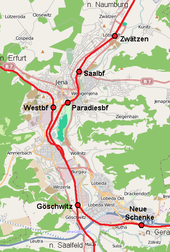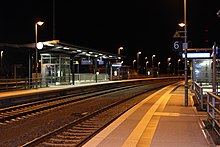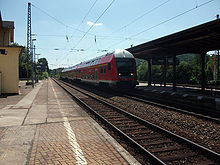Jena-Göschwitz train station
| Jena-Göschwitz | |
|---|---|
|
Platforms Saalbahn (2017)
|
|
| Data | |
| Location in the network | Crossing station |
| Design | Wedge station |
| Platform tracks | 6th |
| abbreviation | UGW |
| IBNR | 8010133 |
| Price range | 3 |
| opening | July 1, 1876 |
| Website URL | www.bahnhof-goeschwitz.de |
| Profile on Bahnhof.de | Jena-Goeschwitz |
| location | |
| City / municipality | Jena |
| Place / district | Göschwitz |
| country | Thuringia |
| Country | Germany |
| Coordinates | 50 ° 53 '2 " N , 11 ° 35' 36" E |
| Railway lines | |
|
|
|
| Railway stations in Thuringia | |
The Jena-Göschwitz station ( Göschwitz (Saale) until December 2010 ) is a wedge station in the Göschwitz district of Jena . The station, located at 152.21 meters above sea level, is located at route kilometers 32.22 of the Saalbahn and 27.50 kilometers of the Weimar-Geraer Bahn and was opened on July 1, 1876. The former second class station is classified under category 4 in the Deutsche Bahn station categorization.
Infrastructure
The track systems were still quite modest when the station was founded (three tracks and one switch connection per railway company). In 1879, the Saal-Eisenbahn-Gesellschaft opened what is now called Gleis 2, the platform, and by 1890 the length of the tracks had doubled. Since then, the railway systems have had to be constantly expanded in line with the growing demand. For example, the Göschwitz cement works received its own siding with a loading ramp.
Around 1938 a temporary replacement station with seven tracks had to be set up to enable the construction of the Saale Valley Viaduct of today's federal motorway 4 , the branch from the Weimar-Geraer Bahn line was at kilometer 28.25. This provisional facility was dismantled after the viaduct was completed.
From February 15, 1940, the route between Saalfeld and Göschwitz was electrically accessible. In the Second World War, in contrast to stations like Jena Saalbf or Saalfeld (Saale), the station's facilities were not damaged very much, but it was hardly possible to carry out major repairs in the following years. In 1946 the overhead line was switched off and dismantled along with the second track as part of the reparations payments to the Soviet Union. Between 1965 and 1973, the track system was completely renovated by the Deutsche Reichsbahn (DR) and the dual track system of all adjoining sections of the line was restored.
The station building of the Weimar-Geraer Eisenbahn-Gesellschaft was shared with the Saalbahn-Gesellschaft for rent. It was rebuilt in 1959.
The Weimar-Geraer Bahn had a steam-powered water station in Göschwitz long before the turn of the century. After 1900, several other supply systems followed (including a 16.2 meter turntable in 1902 and a small locomotive shed). This is how the Göschwitz / Saale locomotive deployment center came about. After 1914, the large locomotive shed and ancillary facilities were built (since 1915 "Göschwitz Station Locksmith's" / locomotive reserve). The facilities also included the older water tower built in 1907. In the southern part of the station, a further water tower was built in 1934 near the small Saale bridge, which, in contrast to the one mentioned above, which was demolished in 1977 in the course of the construction of the new switchboard and the new service building, still exists today. The coal holds were in the locomotive control building until 1957, when the building was expanded.
In 1994 and 1996 the Göschwitz train station was also rebuilt and again fitted with overhead line systems as part of the second Saalbahn electrification; after completion of the work, the so-called "Junior-Bahnhof Göschwitz" was launched (trainee location). In this way, a small part of the extensive facilities can be saved from deterioration. Furthermore, the track underpasses and platform roofs were repainted or provided with covers and new train destination indicators (fall leaf indicators in blue / white) were installed. In connection with this renovation, the track connections from track 4 to tracks 3, 2 and 1 on the Saalbahn side and to tracks 8 and 9 of the Weimar-Geraer Bahn were removed. Tracks 1–4 are spanned with catenary.
Track 5 was dismantled in 2011. In 2014, the previous platforms 4 and 6 (after the reconstruction of platforms 4 and 5) and the construction of a new platform (after the reconstruction of track 6) as well as the addition of elevators to the platform tunnel will take place. Deutsche Bahn initially planned to raise platforms 1-3 on the Saalbahn to a height of 76 centimeters. Since this dimension differs from that of the surrounding stations, a height of 55 centimeters was rescheduled. The construction work is scheduled to last from February to December 2020.
Systems for connecting traffic

In 1886 the private siding to the Saxon-Thuringian Portland cement factory, Prüssing & Co. KG aA was built.
In 1968, the Zeiss-Werke received its own connecting line as part of the new production facilities in Göschwitz; today's Göschwitz industrial park is located in this area. V10B (LKM 252241, LKM 252325) were responsible for the shunting. From the siding of the cement works, a siding developed for the resulting concrete slab plant, which was used for the receipt of building materials and the dispatch of prefabricated residential concrete parts produced there .
In 1969, tracks 1 to 10 were rebuilt, as the systems were in no way able to cope with the steadily increasing volume and the traffic therefore even backed up to other train stations.
The area of the Plattenwerk connection was greatly expanded between 1975 and 1980 and made usable for the newly built heating plant . There were signal-secured entrances / exits from / to the Saalbahn, three sidings and two tracks for oil bunkering. Another track led to the machine house. While machines and building materials were delivered in the construction phase, the heating plant developed into the main connection and legal entity of this connecting railway, the panel plant was degraded to a secondary connection. In this sense, track, signaling and safety systems often had to be moved and / or rebuilt, which also affected the Gn signal box (Göschwitz Nord).
From 1980, due to an oil crisis, the heating plant was expanded to include lignite firing systems, whereby the old oil firing tract was only used in very urgent cases and was practically shut down. In this context, the railway had to transport considerable amounts of lignite to and combustion residues from the plant; over 20 tracks and some additional facilities, such as a defrosting hall or facilities for loading the freight wagons with ash, were built. Several different unloading options were even created for different types of wagons, as no uniform wagon type was available in sufficient quantities. It could thus Fad - / Fal - Ea and the non-tilting E -vans be discharged. The capacity of the connecting railway was around 6,000 tons of coal per day, i.e. six full trains.
Initially, two V 22s were used to operate the connecting line ( 262310 and 262311 , Lokomotivbau Karl Marx Babelsberg 1971). After the expansion, the heating plant received a V 60 from Hennigsdorf ( 17694 , built in 1983). Since the Deutsche Reichsbahn increasingly had to save diesel fuel, the thermal power station procured two fireless locomotives ( 03108, FLC 14893/1986 and 03055/1984 from Raw Meiningen ). These locomotives were used until the end of service on the connecting line in 1991 and were purchased in 1992 by 52 8075 of the IGE Werrabahn Eisenach as a spare part donor.
Signal boxes, signaling and security technology
Around 1900 the Saalbahn- and Weimar-Geraer Eisenbahn-Gesellschaft built their own signal boxes in the station area.
In 1977 the new central interlocking B 1 was opened, in the course of which the use of the modified signaling and security systems began. The demolition of the “old” guard signal boxes Gn (north), Go ( Weimaer-Geraer Bahn , east) and Gw ( Saalbahn , south) took place in 1977/78. The former signal box G was converted into an office building between 1982 and 1984.
The interlocking type Gs II DR from the Plant for Signal and Security Technology Berlin (WSSB) was used as security technology until the end of 2011 . As only one central signal box was used, the efficiency was high. Since November 27, 2011, the entire operation has been remotely controlled by electronic interlocking (ESTW) from the Leipzig operations center.
Station name
As early as 1923, the city of Jena applied for the station to be renamed from “Göschwitz” to “Jena Süd”, but this was rejected. At the same time this was practiced at the Saalbahnhof ("Jena Nord"). In 1953, the Deutsche Reichsbahn suggested to the Göschwitz mayor to change the name to “Göschwitz / Saale” or “Jena Süd”. The first variant was preferred because a new incorporation of the place into the city of Jena was not in sight. Göschwitz has been part of Jena since 1969, but the name of the station has remained unchanged, so that the city of Jena has often submitted proposals for a renaming. In December 2010, Deutsche Bahn announced that it would rename the station “Jena-Göschwitz”, which it finally did.
meaning
The train station is on the so-called Central Germany connection . The station's heyday were probably those between 1960 and 1990. A very large volume of goods had to be handled by the heating plant and Carl Zeiss Jena, among others . In addition, trains were also formed (for example, freight trains from Naumburg (Saale) , Weißenfels , Saalfeld (Saale), Weimar, Neue Schenke and Gera were remodeled, quickly adding up to over 500 wagons a day). In 1971, a container transshipment point was established, which by 1987 had capacity for 50,000 large containers that were often shipped to the Soviet Union, but also worldwide. Trucks were responsible for the local transport of some container loads to surrounding towns such as Apolda , Kahla (Thür) or Stadtroda . In addition, around 50 percent of the total city population lived in the southern districts of Jenas, Lobeda and Winzerla . The rush hour traffic for the local plants and businesses contributed to this. It was also planned to build a new reception building.
At the beginning of the 1970s, Jena was to become the scientific and technical center of the Council for Mutual Economic Aid (RGW). For this purpose, the city was to be fundamentally rebuilt and a monorail was to be built (see here ), which would not have passed without numerous changes at Göschwitz station. These ideas - which were by no means compatible with reality - disappeared as quickly as they had arisen.
In the years since 1957, Göschwitz was home to one of the largest locomotive stations of the Deutsche Reichsbahn with over 150 employees, and a little later the largest transshipment station between Großheringen and Saalfeld (Saale).
After the peaceful revolution, the first container transshipment point was taken out of service in 1990, whereupon the formation of freight trains was also stopped between 1992 and 1995; the locomotives were delivered to Saalfeld (Saale). From 1991 there was no connecting traffic, for example from and to the once so important Zeiss factory tracks (due to the restructuring, a connecting line was no longer necessary from the new perspective) or the heating plant (this connecting line was taken over by a private user), instead of; the panel factory ceased production around the same time. In 1997/98 the supervision for passenger and freight stations was abolished, which also applied to locomotive control and train station. Today the site appears neglected to the viewer.
Freight traffic on the Weimar-Geraer Bahn was also discontinued, so that today Göschwitz station is only used for the short-term parking of goods trains running on the Saalbahn. According to DB Cargo, it was not worth keeping the freight tariff point, MORA C did the rest in 2001.
Since about 1960 the Göschwitz station was also the role of the transport budget to fast-moving trains. The last weekend repeater trains ( IC ) have not stopped in Göschwitz since the timetable change on December 12, 2005, so that the station was finally separated from the long-distance travel network. After all, individual trains on IC lines 50 and 61 still stop . As regional passenger trains that are used or end here, two-hour train pairs from / to Weimar as well as a few amplifier / late trains have been preserved from Monday to Friday. However, the volume of this traffic cannot be compared with that of earlier times.
Encouraged by the Transport Minister of the Free State of Thuringia, there was again a discussion in 2007 about whether the Göschwitz station should be expanded into the Jena main station. The background to the demand was the connection of long-distance and local traffic on Saalbahn and Central-Germany connections, which is possible in principle, but cannot be implemented with the existing systems, which can not be taken over by the Jena West and -Paradies train stations due to their location in the network. The DB had signaled their interest, as modernization of the station was planned for 2011 anyway. The lengths of the platforms on the Central-Germany connection, which were renewed in 2014, are sufficient for Intercity-2 trains .
Due to the Stadler KISS car set taken over from the Westbahn on the new IC line between Dresden and Rostock, there is a nightly transfer from the plant in Vienna to the said route. Because of this trip, Göschwitz station has benefited from another intercity stop since March 2020.
Long-distance and regional transport
| line | Course of the journey | Cycle (min) | operator |
|---|---|---|---|
| IC 17 | ( Warnemünde -) Rostock - Berlin - Halle (Saale) - Jena-Göschwitz - Nuremberg - Passau - Linz - Vienna Hbf | A pair of trains | DB , ÖBB |
| IC 51 | Düsseldorf / Cologne - Dortmund - Kassel - Eisenach - Erfurt - Weimar - Jena West - Jena-Göschwitz - Gera Hbf | Two pairs of trains | DB long-distance transport |
| Kassel-Wilhelmshöhe - Bebra - Eisenach - Erfurt - Weimar - Jena-West - Jena-Göschwitz - Gera Hbf | A pair of trains | ||
| IC 61 | Leipzig - Naumburg (Saale) - Jena-Göschwitz - Saalfeld (Saale) - Bamberg - Nuremberg - Aalen - Stuttgart - Karlsruhe | Individual trains | |
| RE | Leipzig - Naumburg (Saale ) - Jena-Göschwitz - Saalfeld (Saale) - Kronach - Lichtenfels - Bamberg - Nuremberg | 120 | DB Regio Bavaria |
| RE 1 | Göttingen - Leinefelde - Erfurt - Weimar - Jena West - Jena-Göschwitz - Gera - Glauchau (Sachs) | 120 | DB Regio Southeast |
| RE 3 | Erfurt - Weimar - Jena West - Jena-Göschwitz - Gera - Altenburg / Greiz | 120 | |
| Erfurt - Weimar - Jena West - Jena-Göschwitz | 120 | ||
| RE 15 | Saalfeld (Saale) - Rudolstadt - Kahla - Jena-Göschwitz - Jena Paradies - Jena Saalbahnhof | 60 | Abellio |
| RE 18 | Jena-Göschwitz - Jena Paradies - Bad Kösen - Naumburg (S) - Weißenfels - Merseburg - Halle (Saale) | Individual trains | DB Regio Southeast |
| RE 51 | Erfurt - Weimar - Jena West - Jena-Göschwitz - Stadtroda - Gera Hbf | Three pairs of trains | DB long-distance transport |
| EB 21 | Erfurt - Weimar - Jena West - Jena-Göschwitz - Hermsdorf-Klosterlausnitz - Gera |
60 (Mon-Fri) 120 (Sat-Sun) |
Erfurt Railway |
| RB 25 | Saalfeld (S) - Rudolstadt - Kahla - Jena-Göschwitz - Bad Kösen - Naumburg (S) - Weißenfels - Merseburg - Halle (S) | 60 | Abellio |
| EB 28 | Jena Saalbahnhof - Jena Paradies - Jena-Göschwitz - Kahla (Thür) - Orlamünde - Pößneck | 60 | Erfurt Railway |
Local traffic connection
The connection to the public transport is made by tram lines 1/4 and 3. The train station can be reached on foot (approx. 10 minutes) from the terminus of bus line 12 (not between 9 p.m. and 4 a.m.).
Between July 2007 and December 2009, an extension of the Jena tram network from Lobeda-West via Göschwitzer Bahnhof to Burgau was built. The first section Lobeda-West – Göschwitz station was put into preliminary operation on May 20, 2009 by extending Line 3, the remaining section of Göschwitz – Burgau station followed on December 17, 2009. On that day, an extensive change of the line network took place so that the Stop at Bahnhof Göschwitz has been served by two tram lines since then. This means that there are free connections to most of the city districts of Jena accessible by tram. Bus line 18 ensures the connection to the western parts of the city. The subject of further investigations should be whether a connection point with regional bus lines can also be set up at this point.
For many years, the train station's public transport connection was inadequate, which is why Göschwitz train station could not play the role of a local transport hub. Now that this deficiency has been remedied, the station could play a bigger role again in passenger traffic.
literature
- Werner Drescher: The Saalbahn - The history of the railway between Großheringen, Jena and Saalfeld . EK-Verlag, Freiburg 2004, ISBN 3-88255-586-6 .
- Werner Drescher: The Weimar-Geraer Bahn - From the private railway to part of the Central-Germany connection . EK-Verlag, Freiburg 2001, ISBN 3-88255-451-7 .
- Günter Fromm: Railways in Thuringia - data and facts . Rockstuhl Verlag, Bad Langensalza 1992, ISBN 3-929000-24-5 .
- Günter Fromm: Thuringian Railway Line Lexicon 1846–1992 - The Royal Railway Directorate and the Reich Railway Directorate Erfurt 1882–1992 & Railways in Thuringia - dates and facts 1846–1992 . Rockstuhl Publishing House, Bad Langensalza 1996, ISBN 3-929000-33-4 .
- VIDEO: The Franconian Forest and Saale Valley Railway - yesterday & today *. EK-Verlag, Freiburg / Brsg., Feb. 2005. Order no. 5700
- DVD: The Franconian Forest and Saale Valley Railway - yesterday & today *. EK-Verlag, Freiburg / Brsg., 2005. Order no. 8021
- as well as the videos / DVDs “Cab rides Saalbahn / Frankenwaldbahn” from EK-Verlag, Freiburg / Brsg.
* Note: The name "Saaletalbahn" is incorrect and refers to the Gemünden am Main – Bad Kissingen route.
Web links
- The track system as well as some signals and permissible speeds on the OpenRailwayMap
Individual evidence
- ↑ Werner Drescher: The Saalbahn - The history of the railway between Großheringen, Jena and Saalfeld . EK-Verlag, Freiburg 2004, ISBN 3-88255-586-6 , p. 44
- ^ Thomas Beier: New platform arrives at Jena-Göschwitz station . In: TLZ . August 7, 2014 ( online ).
- ↑ DB Netze: Explanatory Report. In: Planning approval for the DB Netz AG construction project: Jena Göschwitz traffic station, change to platforms 1-3. Retrieved December 20, 2018 .
- ↑ The platforms in Jena-Göschwitz are being renewed. Deutsche Bahn AG, February 21, 2020, accessed on March 4, 2020 .
- ^ Renaming of the station "Göschwitz" to "Jena-Göschwitz". In: jenapolis.de. April 30, 2010, archived from the original on July 19, 2011 ; Retrieved on June 4, 2010 (original website no longer available).
- ^ History. In: bahnhof-goeschwitz.de. Retrieved January 9, 2016 .
- ↑ Jena-Göschwitz. DB Station & Service, accessed on December 11, 2018 .
- ↑ Germany March 9, 2020: New DB Intercity double-decker trains (ex WESTbahn) on rails. In: info24news.net. Info 24 - Public Transport Switzerland - Europe, March 9, 2020, accessed on July 4, 2020 .
- ↑ JeNah - on new paths ( memento from January 22, 2010 in the Internet Archive ), passenger information from Jenaer Nahverkehrsgesellschaft mbH, accessed on January 9, 2009
- ↑ City of Jena, traffic planning and civil engineering office: Update of the local transport plan of the city of Jena 2008–2012 ( Memento from March 4, 2016 in the Internet Archive ) (PDF; 1.7 MB), p. 23









